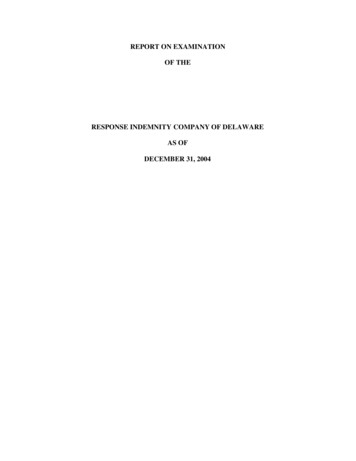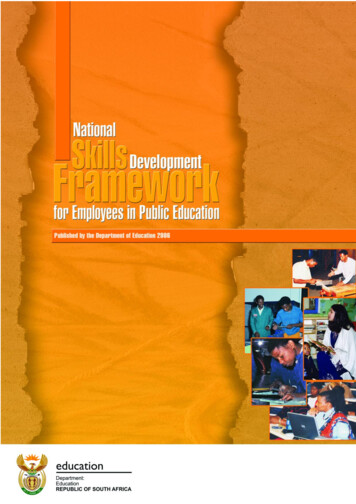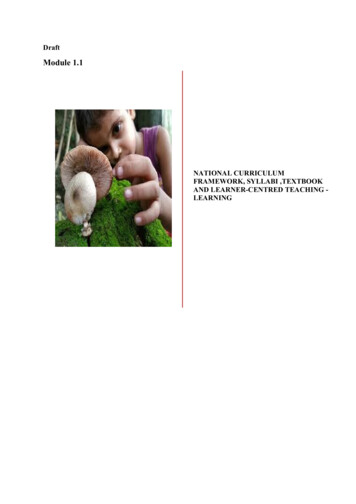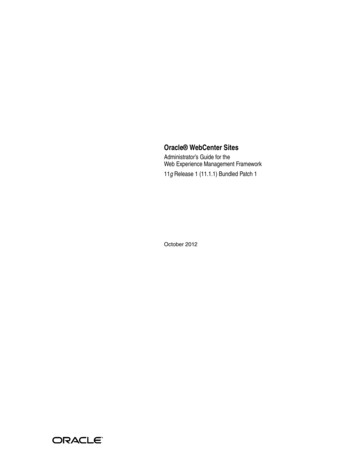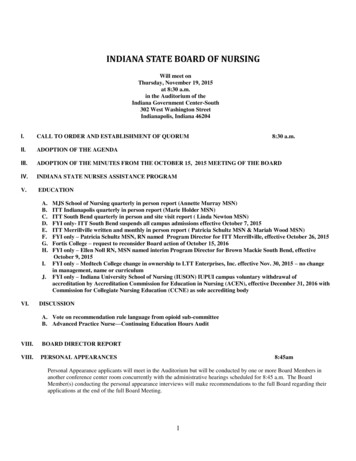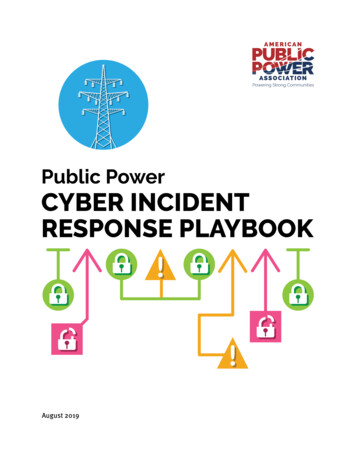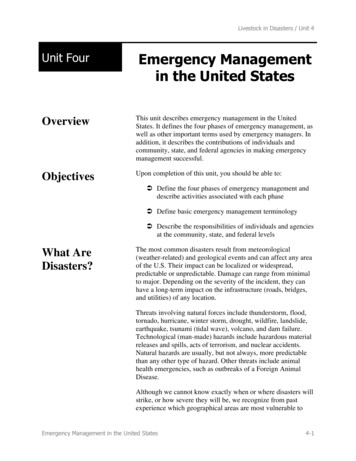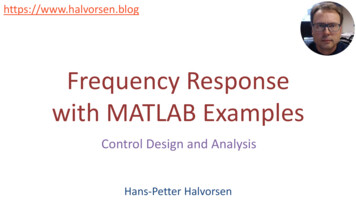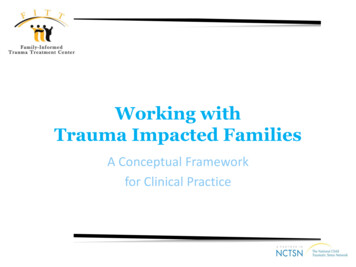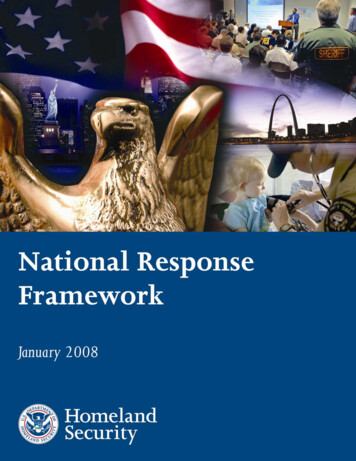
Transcription
This National Response Framework (NRF) is a guide to how the Nation conducts all-hazardsresponse. It is built upon scalable, flexible, and adaptable coordinating structures to alignkey roles and responsibilities across the Nation, linking all levels of government,nongovernmental organizations, and the private sector. It is intended to capture specificauthorities and best practices for managing incidents that range from the serious but purelylocal, to large-scale terrorist attacks or catastrophic natural disasters.This core document, along with the Emergency Support Function Annexes and SupportAnnexes (available at the NRF Resource Cente r, http://www.fema.gov/NRF), supersedesthe corresponding sections of the National Response Plan (2004, with 2006 revisions). TheIncident Annexes remain in effect until superseded at a later date. The President hasapproved this National Response Framework.Washington, DCJanuary 2008January 2008National Response Fram eworkPage i
Intentionally Left BlankPage iiNational Response Fram eworkJanuary 2008
CONTENTSINTRODUCTION. 1Overview . 1Framework Unpacked. 3Scope. 7Response Doctrine. 8Part of a Broader Strategy . 12CHAPTER I – ROLES AND RESPONSIBILITIES . 15Local . 15The Private Sector and NGOs. 18States, Territories, and Tribal Governments . 21Federal . 24CHAPTER II – RESPONSE ACTIONS . 27Introduction . 27Prepare . 27Respond . 32Recover . 45CHAPTER III – RESPONSE ORGANIZATION . 47Introduction . 47Key Concepts . 48Local Response: Structures and Staffing . 49State Response: Structures and Staffing . 51Federal Response: Structures and Staffing . 53CHAPTER IV – PLANNING: A CRITICAL ELEMENT OF EFFECTIVE RESPONSE . 71The Framework and Planning. 71The Value of Planning . 71National Preparedness Architecture . 72The Federal Planning Structure . 73The State, Tribal, and Local Planning Structure . 74Criteria for Successful Planning . 74CHAPTER V – ADDITIONAL RESOURCES . 77Supporting Documents and the NRF Resource Center . 77Effective Date and Framework Implementation . 79ACRONYMS. 81January 2008National Response Fram eworkPage iii
Intentionally Left BlankPage ivNational Response Fram eworkJanuary 2008
INTRODUCTIONOVERVIEWThis Nationa l Response Frame work (NRF) [or Frame work] is a guide to how theNation conducts all-hazards response. It is built upon scalable, flexible, and adaptablecoordinating structures to align key roles and responsibilities across the Nation. It describesspecific authorities and best practices for managing incidents that range from the seriousbut purely local, to large-scale terrorist attacks or catastrophic natural disasters.This document explains the common discipline and structures that have been exercised andmatured at the local, tribal, State, and national levels over time. It describes key lessonslearned from Hurricanes Katrina and Rita, focusing particularly on how the FederalGovernment is organized to support communities and States in catastrophic incidents. Mostimportantly, it builds upon the National Incident Management System (NIMS), whichprovides a consistent template for managing incidents.The te rm “ response” as used in this Frame work includes imme diate actions tosave lives, protect property and the env ironment, and meet basic human needs.Response also includes the execution of emergency plans and actions to support short-termrecovery. The Framework is always in effect, and elements can be implemented as neededon a flexible, scalable basis to improve response.INTENDED AUDIENCEThe Frame work is written especia lly for government executives, private-sectorand nongovernmenta l orga nization (NGO) leade rs, and eme rgency manageme ntpractitioners. First, it is addressed to senior elected and appointed leaders, such asFederal depart ment or agency heads, State Governors, mayors, tribal leaders, and city orcounty officials – those who have a responsibility to provide for effective response. For theNation to be prepared for any and all hazards, its leaders must have a baseline familiaritywith the concepts and mechanics of the Framework.At the same time, the Framework informs emergency management practitioners, explainingthe operating structures and tools used routinely by first responders and emergencymanagers at all levels of government. For these readers, the Framework is augmented withonline access to supporting documents, further training, and an evolving resource forexchanging lessons learned. 11To support users of the Framework, the Department of Homeland Security has created an online NRF ResourceCenter, available at http://www.fema.gov/NRF. This online resource will routinely grow and evolve in support ofthe Framework and those who work with it. The initial postings contain multiple supporting documents, operationalplans, standard forms, and other tools that are commonly used by the incident management community. The sitewill further explain technical aspects of the Framework, and will routinely post supporting documents as they arenewly generated or improved.January 2008National Response Fram eworkPage 1
INTRODUCTIONOne of the challenges to effective response is the relatively high turnove r a ndshort tenure among e lected a nd appointed offic ials responsible for response at alllevels. Effective response hinges upon well-trained leaders and responders who haveinvested in response preparedness, developed engaged partnerships, and are able toachieve shared objectives. The players’ bench is constantly changing, but a concise,common playbook is needed by all.This Framework is intended to supply that essential playbook. It is rooted in extens iveconsultation among practitioners and policy makers at all levels. Operational planning forspecific types of incidents has accelerated and improved nationw ide since the terroristattacks of September 11, 2001 (or 9/11). Such plans will continue to evolve in alignmentwith the Framework.EVOLUTION OF THE FRAMEWORKThis document is an outgrowth of previous iterations of Fede ral planningdocuments. A brief discussion of its history underscores important elements of theFramework and highlights improvements to the previous National Response Plan (NRP).This Framework was preceded 15 years earlier by a Federal Response Plan (1992) thatfocused largely on Federal roles and responsibilities.Follow ing the 9/11 attacks, more urgent efforts were made to understand and implementcommon incident management and response principles and to develop common planningframeworks. The 2004 NRP was an early outgrowth of those discussions, replacing theFederal Response Plan. It was published one year after creation of the Depart ment ofHomeland Security (DHS). The NRP broke new ground in integrating all levels ofgovernment in a common incident management framework. It incorporated incidentcoordination roles for Federal agencies 2 as defined by several new laws and Presidentialdirectives. Nine months after Katrina’s landfall, a notice of change to the NRP was released,incorporating preliminary lessons learned from the 2005 hurricane season.Stake holders suggested c hanges to the NRP – both structural and substantive.Stakeholders have advised that both the initial NRP and its 2006 iteration were bureaucraticand internally repetitive.Users also suggested the NRP was still insufficiently national in its focus, which is to say thatit should speak more clearly to the roles and responsibilities of all parties involved inresponse. Moreover, it was evident that the NRP and its supporting documents did notconstitute a true operational plan in the sense understood by emergency managers. Itscontent was inconsistent with the promise of its title.In the last several years, operational planning on a national basis for specific types ofincidents has matured. Both public and private sectors are making significant homelandsecurity invest ments to strengthen the Nation’s response capability.2Note that within this document, use of the term “agency” when referring to Federal entities is inclusive ofexecutive agencies, departments, and Government corporations.Page 2National Response Fram eworkJanuary 2008
INTRODUCTIONBy adopting the te rm “ fra mework” within the title, this docume nt is now moreaccurately a ligned with its intended purpose. Effective response to an incident is ashared responsibility of governments at all levels, the private sector and NGOs, andindividual citizens. This Framework commits the Federal Government, in partnership w ithlocal, tribal, and State governments and the private sector, to complete both strategic andoperational plans for the incident scenarios specified in the National PreparednessGuidelines. 3 These plans will ultimately improve significantly the Incident Annexes to thisFramework, which have been carried forward from the NRP.FRAMEWORK UNPACKEDThe Framework presents the key response principles, participants, roles, and structures thatguide the Nation’s response operations. The remainder of the Framework is organized asfollows: Chapter I – Roles and Responsibilities. This chapter sharpens the focus on whois involved with emergency manage ment activities at the local, tribal, State, andFederal levels and w ith the private sector and NGOs. Chapter II – Response Actions. This chapter describes what we as a Nationcollectively do to respond to incidents. Chapter III – Response Organization. This chapter explains how we as a Nationare organized to implement response actions. Chapter IV – Planning: A Critical Element of Effe ctive Response. This chapteremphasizes the importance of planning and summarizes the elements of nationalplanning structures. Chapter V – Additiona l Resources. This final chapter summarizes the contentand plan for the online NRF Resource Center, a new, actively managedDHS/Federal Emergency Management Agency Web site that will deliver state-of-theart support for the Framework with additional support tools shaped by and addressedto the response community.HOW THE FRAMEWORK IS ORGANIZEDThe National Response Frame work is comprised of the core docume nt, theEmergency Support Function (ESF), Support, and Incident Annexes, a nd thePartner Guides. The core document describes the doctrine that guides our nationalresponse, roles and responsibilities, response actions, response organizations, and planningrequirements to achieve an effective national response to any incident that occurs. Thecore document of the National Response Framework is effective 60 days after publication.The annexes and Partner Guides will be updated periodically and effective 60 days afterpublication.3The set of scenarios, while not exhaustive, is representative of a broad range of terrorist attacks and naturaldisasters that would stretch the Nation’s prevention and response capabilities. Collectively, they yield coreprevention and response requirements that can help direct comprehensive planning efforts.January 2008National Response Fram eworkPage 3
INTRODUCTIONThe following documents provide moredetailed information to assist practitionersin implementing the Framework:Figure 1. Organization of the Frame work Emergency Support Function Annexes groupFederal resources and capabilities into functionalareas that are most frequently needed in anational response (e.g., Transportation,Firefighting, Mass Care). Support Annexes describe essential supportingaspects that are common to all incidents (e.g.,Financial Management, Volunteer and DonationsManagement, Private-Sector Coordination). Incident Annexes address the unique aspects ofhow we respond to seven broad incidentcategories (e.g., Biological, Nuclear/Radiological,Cyber, Mass Evacuation). Partner Guides provide ready references describing key roles and actions for local,tribal, State, Federal, and private-sector response partners.The National Incide nt Mana gement System (NIMS) is a companion document thatprovides standard command and management structures that apply to response activities.This system provides a consistent, nationwide template to enable Federal, State, tribal, andlocal governments, the private sector, and NGOs to work together to prepare for, prevent,respond to, recover from, and mitigate the effects of incidents regardless of cause, size,location, or complexity. This consistency provides the foundation for utilization of the NIMSfor all incidents, ranging from daily occurrences to incidents requiring a coordinated Federalresponse.These documents are available at the NRF Resource Center, http://www.fema.gov/NRF.RESPONSE: THE WHOAn e ffective, unified national response re quires layered, mutually supportingcapabilities. The Framework systematically incorporates public-sector agencies, theprivate sector, and NGOs. It also emphasizes the importance of personal preparedness byindividuals and households.Communities, tribes, States, the Federal Government, NGOs, and the private sector shouldeach understand their respective roles and responsibilities, and complement each other inachieving shared goals. Each governmental level plays a prominent role in developingcapabilities needed to respond to incidents. This includes developing plans, conductingassessments and exercises, providing and directing resources and capabilities, andgathering lessons learned. These activities require that involved organizations understandtheir roles and responsibilities, and how they fit within and are supported by theFramework.Page 4National Response Fram eworkJanuary 2008
INTRODUCTIONIt is important that each level of governme nt a dapt a nd apply the ge nera l rolesoutline d in the Frame work. To do this, organizations should define key leadership andstaff functions, adopt capabilities-based planning as the method to build responsecapabilities, and impose the discipline needed to plan and operate effectively. PartnerGuides that summarize core Framework concepts and are tailored specifically to leaders atdifferent levels and types of organizations are provided through the online NRF ResourceCenter.Even when a community is overwhelmed by an incident, there is still a core, sovereignresponsibility to be exercised at this local level, with unique response obligations tocoordinate with State, Federal, and private-sector support teams. Each organization orlevel of government therefore has an imperative to fund and execute its own coreemergency management responsibilities.Below is a brief summary of emergency management roles at the local, tribal, State, andFederal levels, as well as the roles of private-sector organizations. Emergency managementis the coordination and integration of all activities necessary to build, sustain, and improvethe capability to prepare for, protect against, respond to, recover from, or mitigate againstthreatened or actual natural disasters, acts of terrorism, or other manmade disasters.Local Governments. Resilie nt communities begin with prepa red individuals anddepend on the leadership and e ngageme nt of loca l governme nt, NGOs, and theprivate sector. Individuals, families, and caregivers to those with special needs shouldenhance their awareness of risk and threats, develop household emergency plans thatinclude care for pets and service animals, and prepare emergency supply kits. 4 Indiv idualscan also volunteer in their communities.Local police, fire, emergency medical serv ices, public health and medical prov iders,emergency management, public works, env ironmental response professionals, and others inthe community are often the first to detect a threat or hazard, or respond to an incident.They also are often the last to leave an incident site or otherwise to cope with the effects ofan incident. The local senior elected or appointed official (the mayor, city manager, orcounty manager) is responsible for ensuring the public safety and welfare of residents. Intoday’s world, senior officials and their emergency managers build the foundation for aneffective response. They organize and integrate their capabilities and resources withneighboring jurisdictions, the State, NGOs, and the private sector. Increasingly, businessesare vital partners within communities wherever retail locations, serv ice sites, manufacturingfacilities, or management offices are located. NGOs and not-for-profit organizations alsoplay a key role in strengthening communities’ response efforts through their knowledge ofhard-to-reach populations, outreach, and services.States, Territories, and Tribal Governments. States, territories, a nd triba lgovernme nts have responsibility for the public health and welfare of the people intheir jurisdiction. State and local governments are closest to those impacted byincidents, and have always had the lead in response and recovery. During response, Statesplay a key role coordinating resources and capabilities throughout the State and obtainingresources and capabilities from other States. States are sovereign entities, and theGovernor has responsibility for public safety and welfare. While U.S. territories,4More information on preparing a household emergency plan is available at http://www.ready.gov.January 2008National Response Fram eworkPage 5
INTRODUCTIONpossessions, freely associated states,5 and tribal governments also have sovereign rights,there are unique factors involved in working with these entities. Stafford Act assistance isavailable to States and to Puerto Rico, the Virgin Islands, Guam, American Samoa, and theCommonwealth of the Northern Mariana Islands, which are included in the definition of“State” in the Stafford Act.6States have signif icant resources of their own, including State emergency management andhomeland security agencies, State police, health agencies, transportation agencies, incidentmanagement teams, specialized teams, and the National Guard. The role of the Stategovernment in response is to supplement local efforts before, during, and after incidents. Ifa State a ntic ipates that its resources may be exceeded, the Governor can re questassistance from the Federa l Gove rnme nt a nd/or from othe r States through mutualaid a nd assistance agreeme nts such as the Eme rgency Ma nagement Assista nceCompact (EMAC). 7The Federal Government. The Federal Government maintains a wide a rray ofcapabilities and resources that ca n be made available upon request of theGovernor. When an incident occurs that exceeds or is anticipated to exceed State, tribal,or local resources, the Federal Government may prov ide resources and capabilities tosupport the State response. For incidents involv ing primary Federal jurisdiction orauthorities (e.g., on a military base or a Federal facility or lands), Federal depart ments oragencies may be the first responders and f irst line of defense, coordinating activities withState, territorial, tribal, and local partners. The Federal Government also maintains workingrelationships with the private sector and NGOs.Pursuant to the Homeland Security Act of 2002 and Homeland Security PresidentialDirective (HSPD) 5, the Secretary of Homeland Security is the principal Federal official fordomestic incident management. Incident management refers to how incidents are managedacross all homeland security activities, including prevention, protection, and response andrecovery. Other Federal depart ments and agenc ies have key responsibilities to supportnational response activities and carry out those responsibilities within the overarchingcoordinating mechanisms of this Framework. DHS coordinates with other agencies to surgeFederal support at the headquarters, regional, and field levels.The Private Sector and NGOs. The private sector and NGOs contribute to responseefforts through engaged partnerships with each level of government. Private-sectororganizations and NGOs are encouraged to develop contingency plans and to work withState and local planners to ensure that their plans are consistent with pertinent plans, theNIMS, and this Framework.5The Framework is applicable to U.S. possessions and insular areas, as well as the Federated States of Micronesiaand the Republic of the Marshall Islands. The U.S. Government does not provide disaster assistance to theRepublic of Palau, in accordance with the Compact of Free Association. Insular areas include Guam, theCommonwealth of the Northern Mariana Islands, American Samoa, and the U.S. Virgin Islands.6Often throughout this Framework, discussion of authorities and roles of States is also intended to incorporatethose of U.S. territories and possessions and tribal nations.7A reference paper on EMAC is available at the NRF Resource Center, http://www.fema.gov/NRF.Page 6National Response Fram eworkJanuary 2008
INTRODUCTIONPrivate-sector organizations play an essentia l role in protecting critica linfrastructure systems and implementing plans for the ra pid restoration of normalcommercia l activities and c ritical infrastructure operations in the event ofdisruption. 8 The protection of critical infrastructure and the ability to rapidly restorenormal commercial activities can mitigate the impact of an incident, improve the quality oflife of individuals, and accelerate the pace of recovery for communities and the Nation.There are not-for-profit owners/operators of critical infrastructure and key resources (CIKR)facilities, notably in healthcare and power generation.NGOs also serve a vita l role at the loca l, State, and national levels by performingessential service missions in times of need. They provide sheltering, emergency foodsupplies, and other vital support services. NGOs bolster and support government efforts atall levels. 9RESPONSE: THE WHAT AND THE HOWThe National Response Frame work is always in effect, a nd e lements can beimplemented at a ny level at any time. The Framework is capabilities based, which is tosay that local governments, tribes, States, and the Federal Government all developfunctional capabilities and identify resources that may be required based on hazardidentif ication and risk assessment, threats, and other potential incidents such as thoserepresented by the National Planning Scenarios.The Frame work describes what we do and how we respond. In short, the NationalResponse Framework explains how, at all levels, the Nation effectively manages all-hazardsresponse consistent with the National Strategy for Homeland Security. The remainder ofthis Introduction explains the Framework’s scope, the response doctrine that animates it,and the preparedness strategy of which it is a part. It correlates with an outline of theoverall document.SCOPEThe Frame work provides structures for implementing nationwide response policyand operationa l coordination for a ll types of domestic inc idents. It can be partiallyor fully implemented in the context of a threat, in anticipation of a significant event, or inresponse to an incident. Selective implementation allows for a scaled response, delivery ofthe resources needed, and an appropriate level of coordination.In this document, incidents include actual or potential emergencies or all-hazards eventsthat range from accidents and natural disasters to actual or potential terrorist attacks. Theyinclude events wholly contained within a single jurisdiction and others that are catastrophicin nature and national in their scope or consequences.8Additional information on protection of critical infrastructure and key resources (CIKR) can be found in the CIKRSupport Annex available at the NRF Resource Center, http://www.fema.gov/NRF.9The American Red Cross is a federally chartered instrumentality of the U.S. Government, but it is not a Federalagency under this Framework.January 2008National Response Fram eworkPage 7
INTRODUCTIONIt is not a lways obv ious at the outset whethe r a seemingly minor event might bethe initia l phase of a larger, rapidly growing threat. The Framework incorporatesstandardized organizational structures that promote on-scene initiative, innovation, andsharing of essential resources drawn from all levels of government, NGOs, and the privatesector. Response must be quickly scalable, flexible, and adaptable.The Framework is also intended to accelerate the assessment and response to incidents thatmay require Federal assistance. In practice, many incidents require v irtually reflexiveactivation of interagency coordination protocols to forestall the incident from becomingworse or to surge more aggressively to contain it. A Federal depart ment or agency actingon independent authority may be the initial and the primary Federal responder, butincidents that require more systematic Federal response efforts are now activelycoordinated through the appropriate Framework mechanisms described in this documentand in its supporting annexes. This initial coordination of Federal incident assessment andresponse efforts is intended to occur seamlessly, without the need for any formal triggermechanism.This Frame work, there fore, eliminates the Incident of Nationa l Significancedeclaration. No such declaration is required by the Framework and none will be made.The authorities of the Secretary of Homeland Security to coordinate large-scale nationalresponses are unaltered by this change. Elimination of this declaration w ill, however,support a more nimble, scalable, and coordinated response by the entire nationalemergency management community.RESPONSE DOCTRINEResponse doctrine de fines basic roles,responsibilities, and ope rationa lconcepts for response across all levelsof government and with NGOs and theprivate sector. The overarching objectiveof response activities centers upon savinglives and protecting property and theenvironment. Five key principles ofoperations define response actions insupport of the Nation’s response mission.Taken together, these five principles ofoperation constitute national responsedoctrine.Response Doctrine:Five Key Principles1. Engaged partnership2. Tiered response3. Scalable, flexible, and adaptableoperational capabilities4. Unity of effort through unified command5. Readiness to actResponse doctrine is rooted in America’s Federal system a nd the Constitution’sdivision of responsibilities betwee n Federa l a nd State governments. Because thisdoctrine reflects the history of emergency management and the distilled w isdom ofresponders and leaders at all levels, it gives elemental form to the Framework.This doctrine “evolves in response to changes in the politic al and strategic landscape,lessons learned from operations, and the introduction of new technologies. Doctrineinfluences the way in which policy and plans are developed, forces are organized andPage 8National Response Fram eworkJanuary 2008
INTRODUCTIONtrained, and equipment is procured. It promotes unity of purpose, guides professionaljudgment, and enables responders to best fulfill their responsibilities.” 1 0Response doctrine evolves slowly. Response strategy and the Framework merit periodicreview and revision, while operational plans supporting the Framework must be tested andimproved through a process of continuous innovation. The last is especially true regardingoperational plans to counter the threat of a terrorist attack.Response doctrine is comprised of five key principles: (1) engaged partnership, (2)tiered response, (3) scalable, flexible, and adaptable operational capabilities, (4) unity ofeffort through unified command, and (5) readiness to act. An introductory word about eachfollows.ENGAGED
January 2008 National Response Framework Page i. This National Response Framework (NRF) is a guide to how the Nation conducts all-hazards response. It is built upon scalable, flexible, and adaptable coordinating structures to align key roles and responsibilit
